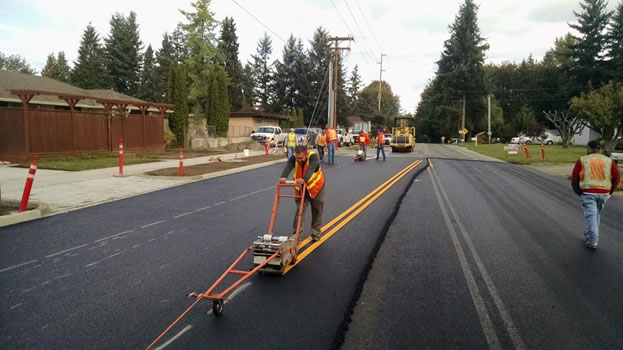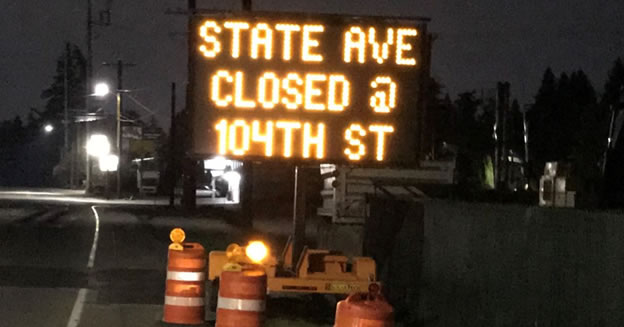
Construction workers performing restriping on a City of Marysville Street.
Source: Credit to City of Marysville
| Project Name | City of Marysville, Washington — Transportation Benefit District |
|---|---|
| Location | Marysville, Washington |
| Project Sponsor | City of Marysville, Washington |
| Program Areas |
|
| Value Capture Techniques | Special Assessment: Transportation Benefit District/Sales Tax Districts |
| Mode | Highway and Local Road, Parking, Transit, & Bicycle |
| Description | A Transportation Benefit District (TBD) is an independent public entity authorized by state law to facilitate transportation improvements. TBDs are primarily funded through vehicle license fees and/or sales taxes. They can be used for the construction, maintenance, and operation costs of improvements that range from roads and transit service to sidewalks and transportation demand management. In 2008, Marysville approved the formation of a TBD to help fund transportation projects and programs. In 2013, Marysville City Council formed a TBD to replace the transportation funding used to preserve, maintain, and expand the City’s infrastructure. The City Council proposed a 0.2-percent sales and use tax for transportation improvements, which voters approved in 2014. The tax increase will raise the sales tax rate in Marysville from 8.6 percent to 8.8 percent. It will generate enough revenue to preserve and repair City streets for a decade and keep Maryville’s tax rate lower than most cities in Snohomish County, which range from 7.7 percent to 9.6 percent. The tax is paid by anyone who shops in Marysville and uses its streets and services. State law requires all revenue generated to be spent only on TBD-designated projects. The tax is limited to 10 years, but can be extended an additional 10 years with voter approval. The TBD also can be dissolved when the district pays off its debts and meets its responsibilities. By the end of 2020, Marysville will have used TBD funding for five capital improvement projects: 2020 Pavement Preservation Program:
First Street Bypass
State Avenue Corridor Widening from 100th St NE to 104th Pl NE
Centennial Trail Connector
Olympic View Park
|
| Cost | $16 million, 10 years preserve and repair Marysville's |
| Funding Sources | The 0.2% sales tax increase will generate enough revenue to continue to preserve and repair Marysville's streets during the next 10 years ($16 million/$1.6 million per year
|
| Project Delivery / Contract Method | Design-Bid-Build |
| Private Partner | N/A |
| Project Advisors / Consultants | N/A |
| Lenders | N/A |
| Duration / Status | 10 years (effective Oct. 1, 2014) |
| Financial Status/Financial Performance |
|
| Innovations |
|
| Related Links / Articles | |
| Contacts | Allan Giffen |

Sign warning drivers of the upcoming closure at 104th Street of State Avenue north of 100th Street extending to complete the next phase of construction.
Source: Credit to City of Marysville